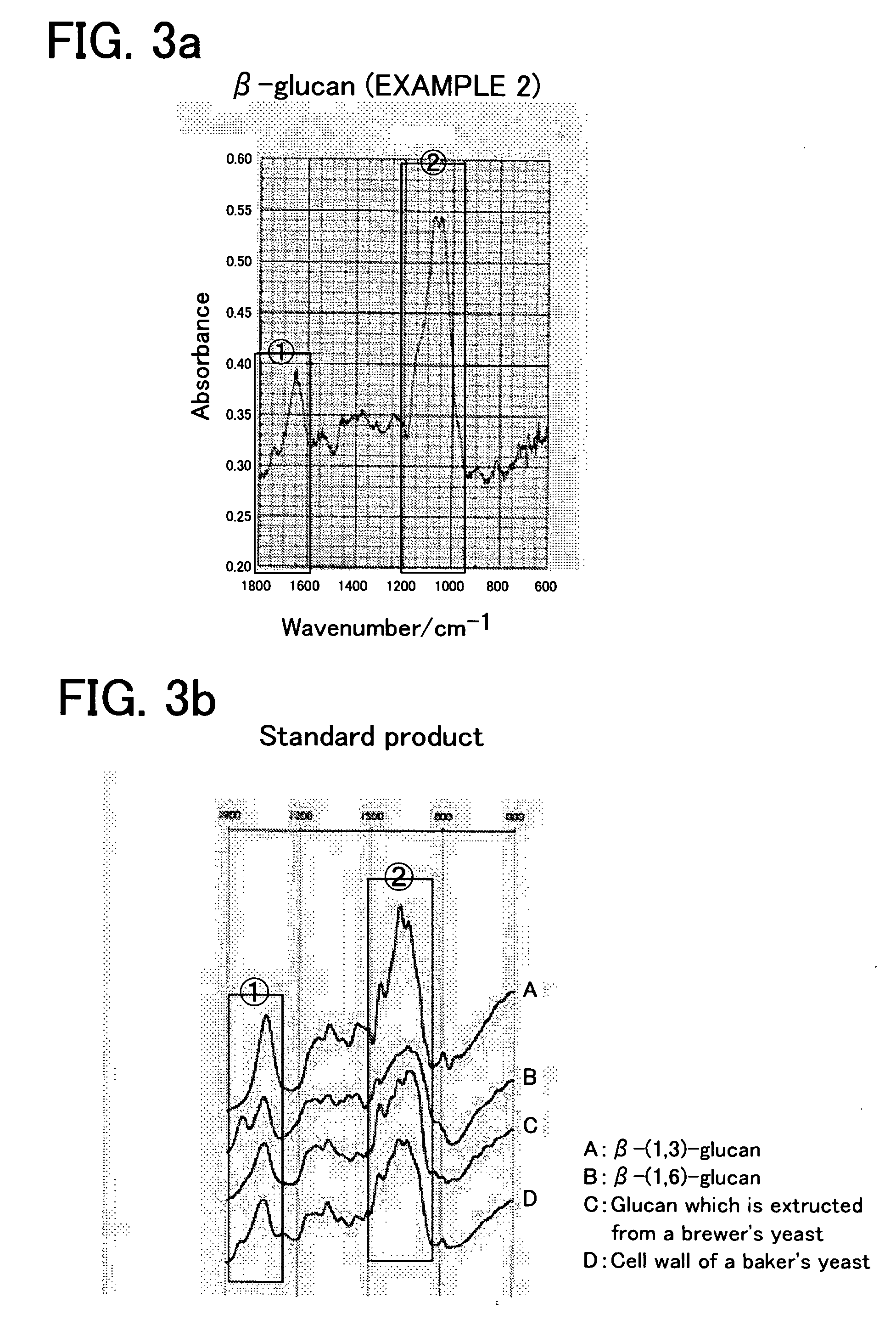Process for producing yeast-derived glucan
a technology of glucan and process, which is applied in the field of process for producing yeast-derived glucan, can solve the problems of complex production process, unfavorable yield, and anxiety in relation to product safety, and achieve the effect of promoting autolysis of yeast, not generating oxidation off-flavor, and high degree of safety
- Summary
- Abstract
- Description
- Claims
- Application Information
AI Technical Summary
Benefits of technology
Problems solved by technology
Method used
Image
Examples
example 1
1-1) Treatment for Pulverizing Yeast Cells
[0057] Yeast cells were pulverized by a method using a beads cell disrupter. In detail, at first 0.05 g each of the dry yeast was measured and put in each tube of Sample Nos. 1˜13 for the cell pulverization. Then, 0.5 ml of mediums as shown in TABLE 1 below was added to each of the tubes, and concentration of the yeast in each of the tubes was adjusted to 10 w / v %. Thereafter, approximately a teaspoonful of beads for the cell pulverization were put in each of the tubes, and the tubes were attached to “Beads Homogenizer Model BC-20 (available from CENTRAL SCIENTIFIC COMMERCE, INC.)”. Subsequently, a rotation axis of the homogenizer was rotated at a rotation speed of 2500 rpm for three minutes, whereby cell walls of the yeast cells were pulverized.
1-2) Treatment for Autolysis
[0058] Temperature of an incubator was set to 50° C., and the tubes of Sample Nos. 4˜7 and Sample Nos. 10˜13, among Sample Nos. 1˜13, which contained the yeasts which w...
example 2
[0065] There was produced a β-glucan by adopting the conditions of effecting the autolysis and the enzyme-treatment of Sample No. 13, which exhibited the most preferable results in the above EXAMPLE 1. In detail, after a sample was prepared by adding 50 g of the dry yeast to 500 ml of the electrolyzed alkaline water (pH=10.0), yeast cells were pulverized by using a ball mill. Subsequently, thus pulverized yeast was autolyzed by being kept in an incubator at 50° C. for 48 hours, and then a basic protease (Proleser-FG-F) was added to the sample, in an amount which corresponds to 0.5% of a weight of the yeast body, and the sample was kept in the incubator at 60° C. for four hours, whereby the yeast of the sample was enzyme-treated. Thereafter, the sample was heat-treated for 10 minutes by using a boiling water, so that the enzyme in the electrolyzed alkaline water was inactivated, and then the sample was centrifuged, and a supernatant thereof was removed. Subsequently, 500 ml of the el...
example 3
3-1) Treatment for Pulverizing Yeast Cells
[0069] 0.05 g of the dry yeast was measured and accommodated in each of tubes for pulverizing cells. Then, 0.5 ml of an electrolyzed alkaline water (pH 9.95) was added to each of the tubes. Also, an alkaline protease (“Proleser-FG-F”) was added to each of the tubes, in an amount which corresponds to a percentage as shown in TABLE 2 below. Thereafter, about a teaspoonful of beads for pulverizing the cells was put into each of the tubes, and cell walls of the yeast cells were pulverized, similar to EXAMPLE 1.
3-2) Treatment for Autolysis and Enzyme-Treatment
[0070] The yeasts of Sample Nos. 14˜25, which were subjected to the above-mentioned treatment for pulverizing cells, were kept at 55° C., which was close to the optimum temperature of the added enzyme, for the respective time indicated in TABLE 2 below (0, 2, 4 or 8 hours). In this way, autolysis of the yeasts was effected with the intracellular enzyme thereof and were enzyme-treated.
3-3...
PUM
| Property | Measurement | Unit |
|---|---|---|
| temperature | aaaaa | aaaaa |
| time | aaaaa | aaaaa |
| temperature | aaaaa | aaaaa |
Abstract
Description
Claims
Application Information
 Login to View More
Login to View More - R&D
- Intellectual Property
- Life Sciences
- Materials
- Tech Scout
- Unparalleled Data Quality
- Higher Quality Content
- 60% Fewer Hallucinations
Browse by: Latest US Patents, China's latest patents, Technical Efficacy Thesaurus, Application Domain, Technology Topic, Popular Technical Reports.
© 2025 PatSnap. All rights reserved.Legal|Privacy policy|Modern Slavery Act Transparency Statement|Sitemap|About US| Contact US: help@patsnap.com



